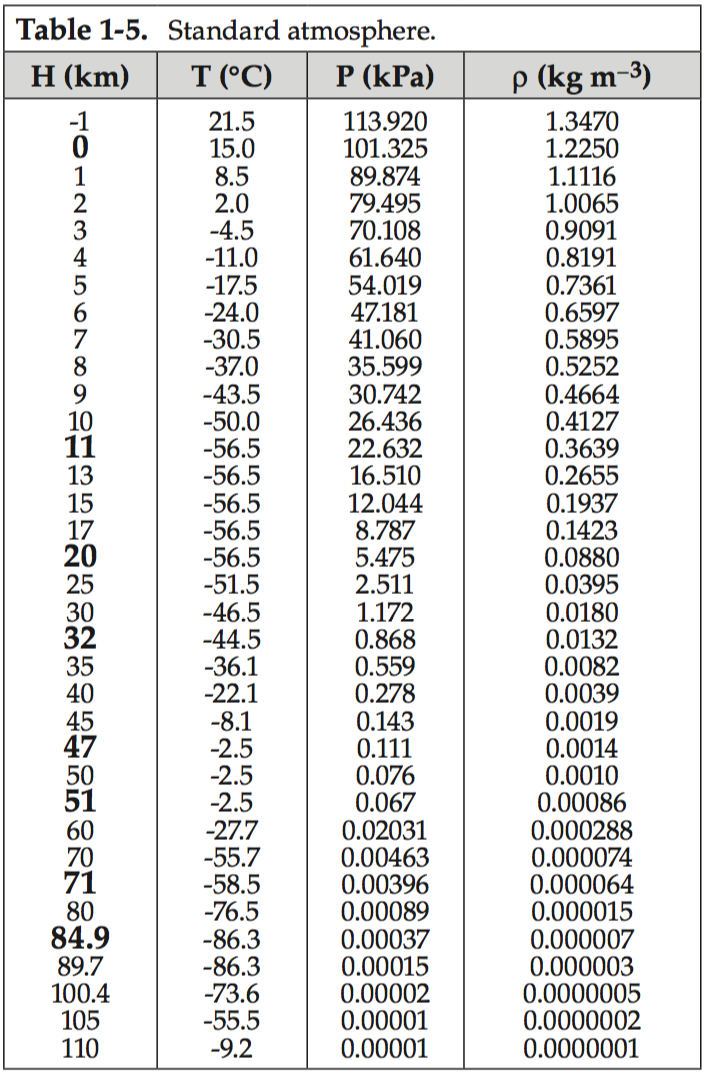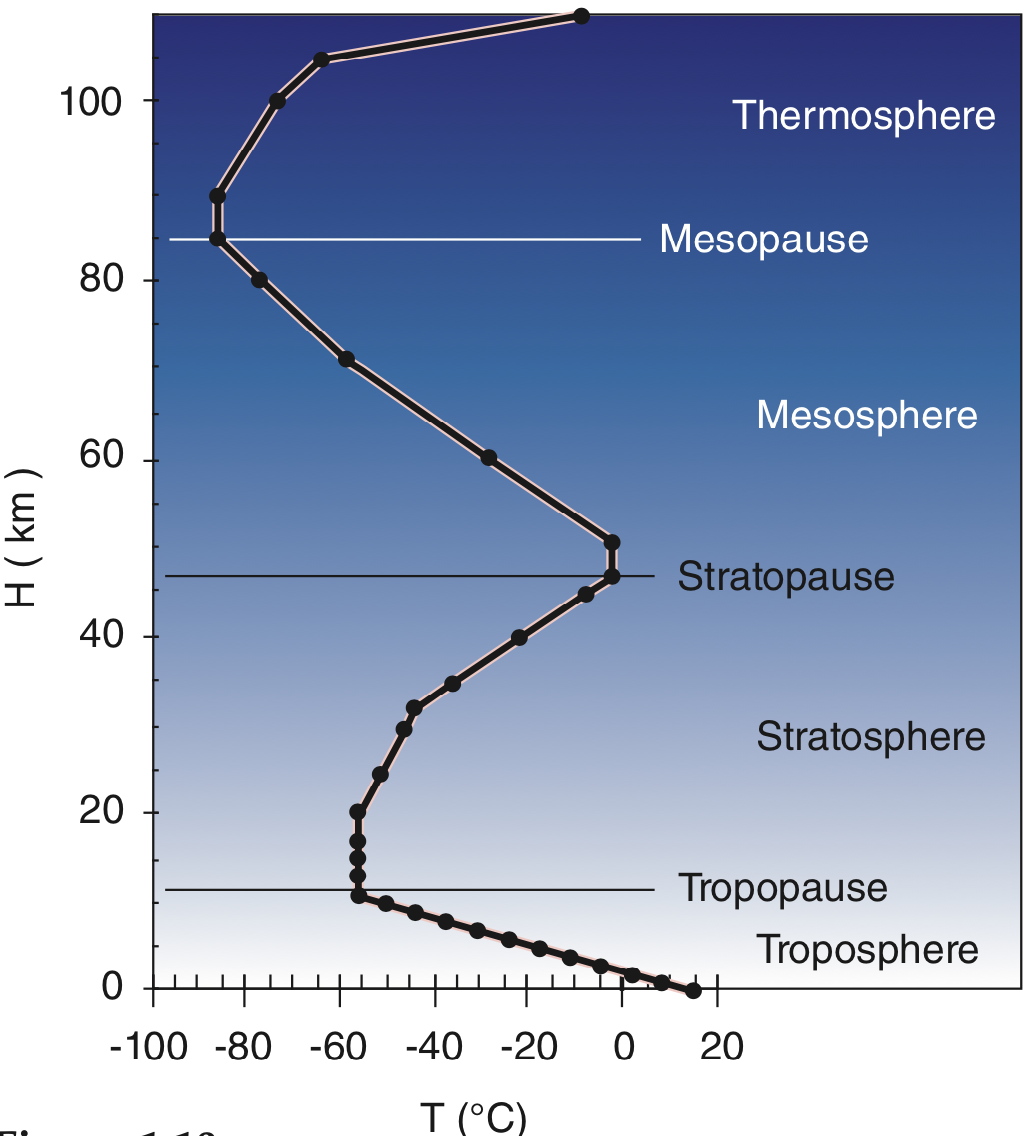ATSC 113 Weather for Sailing, Flying & Snow Sports
Layers in the Standard Atmosphere
Learning Goal 3a. Identify atmospheric layers according to
temperature characteristics in the standard atmosphere
If you have ever climbed a mountain, you know that the air gets
thinner, making it harder to breathe (lower density at higher
altitudes). If you've been in a fast elevator in a tall building, your
ears might pop due to the pressure change (lower pressure at higher
altitudes). These pressure and density characteristics are discussed in
more detail in Learning
Goal 2a.
In the early 1900s when early airplane designs were advancing quickly, pilots were able to climb at first to only 1 km altitude. Later, these early pilots were able to reach altitudes of 3 to 4 km. These early pilots discovered that the higher they flew, the colder the air. This is one reason why each pilot who flew open-cockpit airplanes in the early 1900s wore a heavy leather jacket and a scarf around his/her neck.
The average
variation of air pressure (P), temperature (T), and density (ρ) with
altitude is called the standard atmosphere.
The table below shows how those variables change with height (H) above
sea level. This table is also shown in Learning
Goal 2a.
Pressure and density decrease smoothly with increasing altitude, as is discussed in Learning Goal 2a.
Temperature
However, temperature does not decrease smoothly at all
altitudes. It decreases smoothly at first with increasing
altitude in the bottom of the atmosphere, as was discovered by the
early pilots. But if
you take the data from the table above and plot temperature (T) vs.
height (H), the resulting graph (plotted below) shows that there are
other regions of the atmosphere where temperature increases with
increasing altitude. This temperature structure is used to define
the main layers in the atmosphere, as explained next.
Troposphere
Almost all of our weather (clouds, thunderstorms, hurricanes, etc.)
occur in the troposphere,
which is the bottom part of the atmosphere where temperature decreases
roughly linearly (as a straight line) with height. The average
temperature around the world at sea level is about 15°C , due to its
contact with the sun-heated earth surface. At the 11 km top of the
troposphere the temperature is about –56°C. The top of the troposphere
is called the tropopause (nickname is
"trope"). On average, the troposphere is thinner during winter and
thinner near the poles.
All light aircraft fly in the troposphere. In fact, most general aviation aircraft without supplemental oxygen tanks stay in the bottom third of the troposphere, where the air is dense enough for people to breathe (see Learning Goal 2b).
Stratosphere
Next is the stratosphere, between 11
km and about 47 km above sea level. The top of the stratosphere is
called the stratopause.
In the stratosphere, temperature does not decrease with increasing
height. Instead, the temperature is constant (isothermal) at first, and
then gets warmer as you approach the stratopause. The stratopause is
warm because of the "good" ozone layer there, which gets hot when it
absorbs the harmful ultraviolet rays from the sun.
Many modern commercial aircraft fly in the lower stratosphere to get above most of the storms and weather that are in the troposphere. The Boeing 787 Dreamliner typically flies at about 13.1 km altitude (≈ 43,000 ft). Military aircraft can fly higher, such as the SR-71 Blackbird aircraft, which flies to 25.9 km or 85,000 ft.
Mesosphere
The next layer is the mesosphere, where temperature again decreases with increasing altitude. The top of the mesosphere is called the mesopause.
Aside: Astronaut Wings
Canada: Astronaut wings for the Royal Canadian Air Force.
Image courtesy of the Royal Canadian Air Force.
USA: If you fly above an altitude of 80 km ( or about 264,000 feet), then you earn your astronaut wings. Thus, you would be near or above the mesopause.
Image courtesy of US FAA.
Russian Federation: Cosmonauts are awarded the pilot-cosmonaut title by decree.
Image courtesy of russian federation.
China: Taikonauts are awarded the First-class space merit medal by the Central Committee of the Communist Party of China, the State Council, and the Central Military Commission.
Image courtesy of Baidu.com.
Thermosphere, Exosphere
Above that is the thermosphere, where the temperature increases again with height. Above the thermosphere is the exosphere, where the air is so thin that the molecules do not behave like a gas. The bottom of the exosphere (called the exobase) is somewhere in the 500 to 1,000 km altitude range, and the top is about 197,000 km (about halfway to the moon).
In the exosphere, the air molecules are very far apart from each other. For example, a typical orbital altitude of the Space Shuttle is 400 km above the Earth's surface. At that height, the air molecules are about 16 km apart from each other. The average distance between molecules is called the mean-free path. At that 400 km altitude, the air density is only about 3 x 10-12 kg/m3. But the Shuttle is moving so fast (24.7 times the speed of sound; i.e., Mach 24.7) that it still feels some friction from these air molecules.
When the Space Shuttle begins reentry into the atmosphere, frictional heating starts becoming very important at about 122 km altitude (≈ 400,000 ft), where the air density is about 2 x 10 -8 kg/m3, and the molecular mean-free path is about 4 m between molecules. This reentry heating is extreme all the way down to an altitude of about 70 km altitude (≈230,000 ft), where the air density is about 8 x 10 -5 kg/m3, and the molecular mean-free path is about 1 mm. For comparison, at sea level, the mean-free path between air molecules is a bit less than 0.1 micrometers (about 1/10,000 of a millimeter) and air density is 1.225 kg/m 3. A nice sketch showing the relative depths of the atmosphere layers is on Wikipedia.
Actual vs. Standard Atmosphere
CAUTION: The "standard atmosphere" gives average
conditions. However, the actual temperature structure is
never average. It varies from location to location, season to
season, time to time, weather condition to weather condition. It
can have many zigs and zags in the shape of the temperature profile.
Pilots need to use the actual conditions (temperature, winds, clouds,
weather, etc.) at each time and location along their flight path.
The actual temperature profile at any one instant is described in
learning goal: 3b Static Stability and Atmospheric Soundings.
Key words: standard atmosphere, troposphere, tropopause, stratosphere, stratopause, mesophere, mesopause, exosphere, exosbase, mean-free path
Extra info for experts; not needed for this course.
The International Standard Atmosphere (ISA): Wikipedia.
The US Standard Atmosphere: Wikipedia.
The US Naval Research Lab atmosphere model from the ground to space, for estimating air drag on satellites. Wikipedia.
Image credits. The drawing and table were made by Roland Stull, and all are copyright by him and used with his permission.

